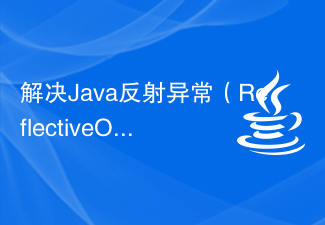 Backend Development
Backend Development Golang
Golang Go language reflection practice: clever use of method reflection to implement business logic
Go language reflection practice: clever use of method reflection to implement business logicMethod reflection allows dynamically calling method information at runtime, including obtaining method values and calling methods. You can get method values and call methods through reflect.Type and reflect.Value types. Method reflection is widely used in dynamic implementation of business logic, allowing methods to be dynamically called based on input to achieve flexible processing.

Go language reflection practice: cleverly using method reflection to implement business logic
Introduction
Reflection is a powerful feature in the Go language that allows a program to inspect and manipulate its types and values at runtime. Method reflection is a special application of the reflection function that allows us to reflect method information and call them dynamically. This article will introduce the basic principles of method reflection in the Go language and demonstrate its application through practical cases.
Basic principles of method reflection
To perform method reflection, we need to use reflect.Type and reflect.Value type. reflect.Type represents type reflection, and reflect.Value represents value reflection.
Get the method value
We can get the reflect.Value# of the specified method of the specified type through the reflect.Type.Method method ##. For example, to get the reflected value of the Eat method of type Animal, you can use the following code:
type Animal struct {
name string
}
func (a *Animal) Eat() string {
return "Animal eating."
}
func main() {
animalType := reflect.TypeOf((*Animal)(nil))
eatMethodValue := animalType.Method(0)
}
Call method
Through thereflect.Value.Call method, we can call methods using reflection values. The Call method receives a parameter list of type []reflect.Value, which contains the values of the method parameters, and returns a return of type []reflect.Value List of values. For example, to call the Eat method of type Animal using reflection, we can use the following code:
args := []reflect.Value{}
result := eatMethodValue.Call(args)
fmt.Println(result[0]) // 输出: Animal eating.
Practical Case: Dynamic Business Logic
A common application scenario of method reflection is to dynamically implement business logic. For example, we can define an interface that contains various methods, and then use reflection to dynamically call these methods to dynamically implement business logic based on different inputs.type Processor interface {
Process(data []interface{})
}
type ProcessorA struct {}
func (p *ProcessorA) Process(data []interface{}) {
// 处理 data 的逻辑
}
type ProcessorB struct {}
func (p *ProcessorB) Process(data []interface{}) {
// 处理 data 的逻辑
}
func ProcessData(processor Processor, data []interface{}) {
processorType := reflect.TypeOf(processor)
processorMethod := processorType.Method(0)
args := []reflect.Value{
reflect.ValueOf(data),
}
processorMethod.Call(args)
}
func main() {
processorA := &ProcessorA{}
processorB := &ProcessorB{}
data := []interface{}{1, 2, 3}
ProcessData(processorA, data)
ProcessData(processorB, data)
}In this example, the Processor interface defines a Process method that receives a data slice and performs the logic of processing the data. We define two types that implement this interface: ProcessorA and ProcessorB. The
ProcessData function uses reflection to dynamically call the Process method. It does this by getting the reflected value of the Process method of type Processor and calling the method using the Call method, passing a slice of data as the method's argument.
The above is the detailed content of Go language reflection practice: clever use of method reflection to implement business logic. For more information, please follow other related articles on the PHP Chinese website!
 解决Java反射异常(ReflectiveOperationException)的方法Aug 26, 2023 am 09:55 AM
解决Java反射异常(ReflectiveOperationException)的方法Aug 26, 2023 am 09:55 AM解决Java反射异常(ReflectiveOperationException)的方法在Java开发中,反射(Reflection)是一种强大的机制,它允许程序在运行时动态地获取和操作类、对象、方法和属性等。通过反射,我们可以实现一些灵活的功能,比如动态创建对象、调用私有方法、获取类的注解等。然而,使用反射也会带来一些潜在的风险和问题,其中之一就是反射异常(
 如何在 Go 语言中使用第三方包?Jun 01, 2024 am 11:39 AM
如何在 Go 语言中使用第三方包?Jun 01, 2024 am 11:39 AM在Go中使用第三方包:使用goget命令安装包,如:gogetgithub.com/user/package。导入包,如:import("github.com/user/package")。示例:使用encoding/json包解析JSON数据:安装:gogetencoding/json导入:import("encoding/json")解析:json.Unmarshal([]byte(jsonString),&data)
 Golang函数的反射和类型断言的应用和底层实现May 16, 2023 pm 12:01 PM
Golang函数的反射和类型断言的应用和底层实现May 16, 2023 pm 12:01 PMGolang函数的反射和类型断言的应用和底层实现在Golang编程中,函数的反射和类型断言是两个非常重要的概念。函数的反射可以让我们在运行时动态的调用函数,而类型断言则可以帮助我们在处理接口类型时进行类型转换操作。本文将深入讨论这两个概念的应用以及他们的底层实现原理。一、函数的反射函数的反射是指在程序运行时获取函数的具体信息,比如函数名、参数个数、参数类型等
 Go 语言:强大而灵活的脚本语言Apr 08, 2024 am 09:57 AM
Go 语言:强大而灵活的脚本语言Apr 08, 2024 am 09:57 AMGo语言是一种现代开源编程语言,以其并发支持、内存安全和跨平台兼容性而闻名。它也是一种出色的脚本语言,提供了丰富的内置函数和实用工具,包括:并发支持:简化同时执行多个任务的脚本编写。内存安全:垃圾回收器自动释放未使用的内存,防止内存泄漏。跨平台兼容性:可以在Windows、Linux、macOS和移动平台上编译。丰富的标准库:提供文件I/O、网络请求和正则表达式等常见脚本功能。
 如何使用 Go 语言定义和使用自定义类型?Jun 05, 2024 pm 12:41 PM
如何使用 Go 语言定义和使用自定义类型?Jun 05, 2024 pm 12:41 PM在Go中,自定义类型可使用type关键字定义(struct),包含命名字段。它们可以通过字段访问运算符访问,并可附加方法来操作实例状态。在实际应用中,自定义类型用于组织复杂数据和简化操作。例如,学生管理系统使用自定义类型Student存储学生信息,并提供计算平均成绩和出勤率的方法。
 Go 语言生态系统:顶尖库一览Apr 08, 2024 pm 06:51 PM
Go 语言生态系统:顶尖库一览Apr 08, 2024 pm 06:51 PMGo语言生态系统提供了丰富且强大的库,其中包括:Gin(用于构建web应用程序的框架)Gorm(用于管理数据库交互的ORM)Zap(用于高性能日志记录)Viper(用于管理应用程序配置)Prometheus(用于监控和报警)这些库帮助开发人员快速有效地构建健壮且可维护的Go应用程序。
 高级Python元编程:动态代码生成和反射Sep 06, 2023 pm 09:13 PM
高级Python元编程:动态代码生成和反射Sep 06, 2023 pm 09:13 PMPython是一种灵活的编程语言,为开发人员提供了广泛的功能和工具。其强大的功能包括元编程——一种先进的技术,使开发人员能够在运行时动态地操作和生成代码。在本文中,我们将踏上高级Python元编程领域的旅程,特别关注动态代码生成和反射。通过采用这些技术,开发人员可以创建能够适应、修改甚至自省的代码,从而为创建灵活高效的应用程序开启了新的可能性世界。通过探索Python中动态代码生成和反射的概念和实际应用,我们将揭示元编程如何彻底改变开发过程,使开发人员能够生成健壮且高度适应性的代码。了解元编程元
 Go 语言中的反射机制的局限性是什么?Jun 09, 2023 pm 11:31 PM
Go 语言中的反射机制的局限性是什么?Jun 09, 2023 pm 11:31 PMGo语言作为一门静态类型语言,在代码编写时需要明确每个变量的类型。但是,在某些情况下,我们需要对程序中的类型进行动态的分析和操作,这时就需要用到反射机制。反射机制可以在程序运行时动态地获取程序对象的类型信息,并能够对其进行分析和操作,非常有用。但是,Go语言中反射机制也存在一些局限性,下面我们来详细了解一下。反射机制对性能的影响使用反射机制可以大大增强代


Hot AI Tools

Undresser.AI Undress
AI-powered app for creating realistic nude photos

AI Clothes Remover
Online AI tool for removing clothes from photos.

Undress AI Tool
Undress images for free

Clothoff.io
AI clothes remover

AI Hentai Generator
Generate AI Hentai for free.

Hot Article

Hot Tools

Dreamweaver Mac version
Visual web development tools

VSCode Windows 64-bit Download
A free and powerful IDE editor launched by Microsoft

MinGW - Minimalist GNU for Windows
This project is in the process of being migrated to osdn.net/projects/mingw, you can continue to follow us there. MinGW: A native Windows port of the GNU Compiler Collection (GCC), freely distributable import libraries and header files for building native Windows applications; includes extensions to the MSVC runtime to support C99 functionality. All MinGW software can run on 64-bit Windows platforms.

PhpStorm Mac version
The latest (2018.2.1) professional PHP integrated development tool

SAP NetWeaver Server Adapter for Eclipse
Integrate Eclipse with SAP NetWeaver application server.





